Phase I_II Study of Lorlatinib in Advanced ALK+ or ROS1+ NSCLC
- 格式:ppt
- 大小:521.00 KB
- 文档页数:9
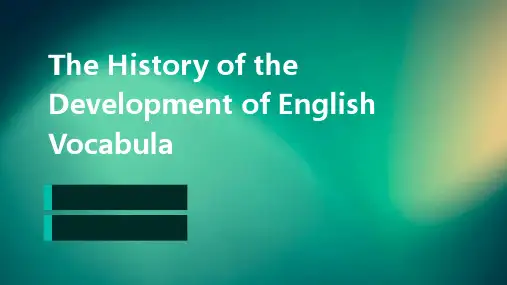
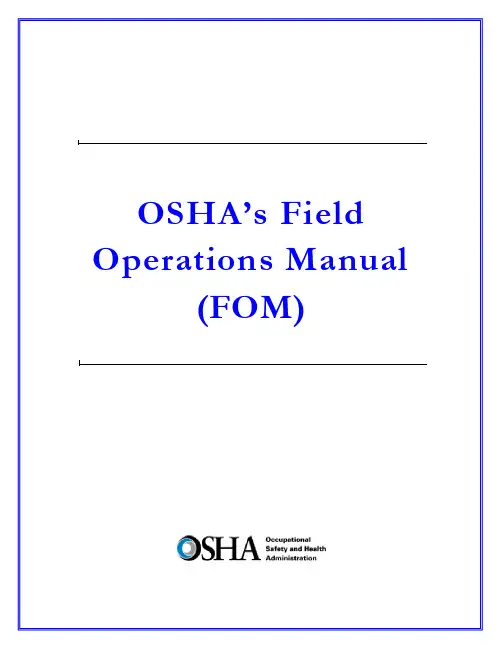
DIRECTIVE NUMBER: CPL 02-00-150 EFFECTIVE DATE: April 22, 2011 SUBJECT: Field Operations Manual (FOM)ABSTRACTPurpose: This instruction cancels and replaces OSHA Instruction CPL 02-00-148,Field Operations Manual (FOM), issued November 9, 2009, whichreplaced the September 26, 1994 Instruction that implemented the FieldInspection Reference Manual (FIRM). The FOM is a revision of OSHA’senforcement policies and procedures manual that provides the field officesa reference document for identifying the responsibilities associated withthe majority of their inspection duties. This Instruction also cancels OSHAInstruction FAP 01-00-003 Federal Agency Safety and Health Programs,May 17, 1996 and Chapter 13 of OSHA Instruction CPL 02-00-045,Revised Field Operations Manual, June 15, 1989.Scope: OSHA-wide.References: Title 29 Code of Federal Regulations §1903.6, Advance Notice ofInspections; 29 Code of Federal Regulations §1903.14, Policy RegardingEmployee Rescue Activities; 29 Code of Federal Regulations §1903.19,Abatement Verification; 29 Code of Federal Regulations §1904.39,Reporting Fatalities and Multiple Hospitalizations to OSHA; and Housingfor Agricultural Workers: Final Rule, Federal Register, March 4, 1980 (45FR 14180).Cancellations: OSHA Instruction CPL 02-00-148, Field Operations Manual, November9, 2009.OSHA Instruction FAP 01-00-003, Federal Agency Safety and HealthPrograms, May 17, 1996.Chapter 13 of OSHA Instruction CPL 02-00-045, Revised FieldOperations Manual, June 15, 1989.State Impact: Notice of Intent and Adoption required. See paragraph VI.Action Offices: National, Regional, and Area OfficesOriginating Office: Directorate of Enforcement Programs Contact: Directorate of Enforcement ProgramsOffice of General Industry Enforcement200 Constitution Avenue, NW, N3 119Washington, DC 20210202-693-1850By and Under the Authority ofDavid Michaels, PhD, MPHAssistant SecretaryExecutive SummaryThis instruction cancels and replaces OSHA Instruction CPL 02-00-148, Field Operations Manual (FOM), issued November 9, 2009. The one remaining part of the prior Field Operations Manual, the chapter on Disclosure, will be added at a later date. This Instruction also cancels OSHA Instruction FAP 01-00-003 Federal Agency Safety and Health Programs, May 17, 1996 and Chapter 13 of OSHA Instruction CPL 02-00-045, Revised Field Operations Manual, June 15, 1989. This Instruction constitutes OSHA’s general enforcement policies and procedures manual for use by the field offices in conducting inspections, issuing citations and proposing penalties.Significant Changes∙A new Table of Contents for the entire FOM is added.∙ A new References section for the entire FOM is added∙ A new Cancellations section for the entire FOM is added.∙Adds a Maritime Industry Sector to Section III of Chapter 10, Industry Sectors.∙Revises sections referring to the Enhanced Enforcement Program (EEP) replacing the information with the Severe Violator Enforcement Program (SVEP).∙Adds Chapter 13, Federal Agency Field Activities.∙Cancels OSHA Instruction FAP 01-00-003, Federal Agency Safety and Health Programs, May 17, 1996.DisclaimerThis manual is intended to provide instruction regarding some of the internal operations of the Occupational Safety and Health Administration (OSHA), and is solely for the benefit of the Government. No duties, rights, or benefits, substantive or procedural, are created or implied by this manual. The contents of this manual are not enforceable by any person or entity against the Department of Labor or the United States. Statements which reflect current Occupational Safety and Health Review Commission or court precedents do not necessarily indicate acquiescence with those precedents.Table of ContentsCHAPTER 1INTRODUCTIONI.PURPOSE. ........................................................................................................... 1-1 II.SCOPE. ................................................................................................................ 1-1 III.REFERENCES .................................................................................................... 1-1 IV.CANCELLATIONS............................................................................................. 1-8 V. ACTION INFORMATION ................................................................................. 1-8A.R ESPONSIBLE O FFICE.......................................................................................................................................... 1-8B.A CTION O FFICES. .................................................................................................................... 1-8C. I NFORMATION O FFICES............................................................................................................ 1-8 VI. STATE IMPACT. ................................................................................................ 1-8 VII.SIGNIFICANT CHANGES. ............................................................................... 1-9 VIII.BACKGROUND. ................................................................................................. 1-9 IX. DEFINITIONS AND TERMINOLOGY. ........................................................ 1-10A.T HE A CT................................................................................................................................................................. 1-10B. C OMPLIANCE S AFETY AND H EALTH O FFICER (CSHO). ...........................................................1-10B.H E/S HE AND H IS/H ERS ..................................................................................................................................... 1-10C.P ROFESSIONAL J UDGMENT............................................................................................................................... 1-10E. W ORKPLACE AND W ORKSITE ......................................................................................................................... 1-10CHAPTER 2PROGRAM PLANNINGI.INTRODUCTION ............................................................................................... 2-1 II.AREA OFFICE RESPONSIBILITIES. .............................................................. 2-1A.P ROVIDING A SSISTANCE TO S MALL E MPLOYERS. ...................................................................................... 2-1B.A REA O FFICE O UTREACH P ROGRAM. ............................................................................................................. 2-1C. R ESPONDING TO R EQUESTS FOR A SSISTANCE. ............................................................................................ 2-2 III. OSHA COOPERATIVE PROGRAMS OVERVIEW. ...................................... 2-2A.V OLUNTARY P ROTECTION P ROGRAM (VPP). ........................................................................... 2-2B.O NSITE C ONSULTATION P ROGRAM. ................................................................................................................ 2-2C.S TRATEGIC P ARTNERSHIPS................................................................................................................................. 2-3D.A LLIANCE P ROGRAM ........................................................................................................................................... 2-3 IV. ENFORCEMENT PROGRAM SCHEDULING. ................................................ 2-4A.G ENERAL ................................................................................................................................................................. 2-4B.I NSPECTION P RIORITY C RITERIA. ..................................................................................................................... 2-4C.E FFECT OF C ONTEST ............................................................................................................................................ 2-5D.E NFORCEMENT E XEMPTIONS AND L IMITATIONS. ....................................................................................... 2-6E.P REEMPTION BY A NOTHER F EDERAL A GENCY ........................................................................................... 2-6F.U NITED S TATES P OSTAL S ERVICE. .................................................................................................................. 2-7G.H OME-B ASED W ORKSITES. ................................................................................................................................ 2-8H.I NSPECTION/I NVESTIGATION T YPES. ............................................................................................................... 2-8 V.UNPROGRAMMED ACTIVITY – HAZARD EVALUATION AND INSPECTION SCHEDULING ............................................................................ 2-9 VI.PROGRAMMED INSPECTIONS. ................................................................... 2-10A.S ITE-S PECIFIC T ARGETING (SST) P ROGRAM. ............................................................................................. 2-10B.S CHEDULING FOR C ONSTRUCTION I NSPECTIONS. ..................................................................................... 2-10C.S CHEDULING FOR M ARITIME I NSPECTIONS. ............................................................................. 2-11D.S PECIAL E MPHASIS P ROGRAMS (SEP S). ................................................................................... 2-12E.N ATIONAL E MPHASIS P ROGRAMS (NEP S) ............................................................................... 2-13F.L OCAL E MPHASIS P ROGRAMS (LEP S) AND R EGIONAL E MPHASIS P ROGRAMS (REP S) ............ 2-13G.O THER S PECIAL P ROGRAMS. ............................................................................................................................ 2-13H.I NSPECTION S CHEDULING AND I NTERFACE WITH C OOPERATIVE P ROGRAM P ARTICIPANTS ....... 2-13CHAPTER 3INSPECTION PROCEDURESI.INSPECTION PREPARATION. .......................................................................... 3-1 II.INSPECTION PLANNING. .................................................................................. 3-1A.R EVIEW OF I NSPECTION H ISTORY .................................................................................................................... 3-1B.R EVIEW OF C OOPERATIVE P ROGRAM P ARTICIPATION .............................................................................. 3-1C.OSHA D ATA I NITIATIVE (ODI) D ATA R EVIEW .......................................................................................... 3-2D.S AFETY AND H EALTH I SSUES R ELATING TO CSHO S.................................................................. 3-2E.A DVANCE N OTICE. ................................................................................................................................................ 3-3F.P RE-I NSPECTION C OMPULSORY P ROCESS ...................................................................................................... 3-5G.P ERSONAL S ECURITY C LEARANCE. ................................................................................................................. 3-5H.E XPERT A SSISTANCE. ........................................................................................................................................... 3-5 III. INSPECTION SCOPE. ......................................................................................... 3-6A.C OMPREHENSIVE ................................................................................................................................................... 3-6B.P ARTIAL. ................................................................................................................................................................... 3-6 IV. CONDUCT OF INSPECTION .............................................................................. 3-6A.T IME OF I NSPECTION............................................................................................................................................. 3-6B.P RESENTING C REDENTIALS. ............................................................................................................................... 3-6C.R EFUSAL TO P ERMIT I NSPECTION AND I NTERFERENCE ............................................................................. 3-7D.E MPLOYEE P ARTICIPATION. ............................................................................................................................... 3-9E.R ELEASE FOR E NTRY ............................................................................................................................................ 3-9F.B ANKRUPT OR O UT OF B USINESS. .................................................................................................................... 3-9G.E MPLOYEE R ESPONSIBILITIES. ................................................................................................. 3-10H.S TRIKE OR L ABOR D ISPUTE ............................................................................................................................. 3-10I. V ARIANCES. .......................................................................................................................................................... 3-11 V. OPENING CONFERENCE. ................................................................................ 3-11A.G ENERAL ................................................................................................................................................................ 3-11B.R EVIEW OF A PPROPRIATION A CT E XEMPTIONS AND L IMITATION. ..................................................... 3-13C.R EVIEW S CREENING FOR P ROCESS S AFETY M ANAGEMENT (PSM) C OVERAGE............................. 3-13D.R EVIEW OF V OLUNTARY C OMPLIANCE P ROGRAMS. ................................................................................ 3-14E.D ISRUPTIVE C ONDUCT. ...................................................................................................................................... 3-15F.C LASSIFIED A REAS ............................................................................................................................................. 3-16VI. REVIEW OF RECORDS. ................................................................................... 3-16A.I NJURY AND I LLNESS R ECORDS...................................................................................................................... 3-16B.R ECORDING C RITERIA. ...................................................................................................................................... 3-18C. R ECORDKEEPING D EFICIENCIES. .................................................................................................................. 3-18 VII. WALKAROUND INSPECTION. ....................................................................... 3-19A.W ALKAROUND R EPRESENTATIVES ............................................................................................................... 3-19B.E VALUATION OF S AFETY AND H EALTH M ANAGEMENT S YSTEM. ....................................................... 3-20C.R ECORD A LL F ACTS P ERTINENT TO A V IOLATION. ................................................................................. 3-20D.T ESTIFYING IN H EARINGS ................................................................................................................................ 3-21E.T RADE S ECRETS. ................................................................................................................................................. 3-21F.C OLLECTING S AMPLES. ..................................................................................................................................... 3-22G.P HOTOGRAPHS AND V IDEOTAPES.................................................................................................................. 3-22H.V IOLATIONS OF O THER L AWS. ....................................................................................................................... 3-23I.I NTERVIEWS OF N ON-M ANAGERIAL E MPLOYEES .................................................................................... 3-23J.M ULTI-E MPLOYER W ORKSITES ..................................................................................................................... 3-27 K.A DMINISTRATIVE S UBPOENA.......................................................................................................................... 3-27 L.E MPLOYER A BATEMENT A SSISTANCE. ........................................................................................................ 3-27 VIII. CLOSING CONFERENCE. .............................................................................. 3-28A.P ARTICIPANTS. ..................................................................................................................................................... 3-28B.D ISCUSSION I TEMS. ............................................................................................................................................ 3-28C.A DVICE TO A TTENDEES .................................................................................................................................... 3-29D.P ENALTIES............................................................................................................................................................. 3-30E.F EASIBLE A DMINISTRATIVE, W ORK P RACTICE AND E NGINEERING C ONTROLS. ............................ 3-30F.R EDUCING E MPLOYEE E XPOSURE. ................................................................................................................ 3-32G.A BATEMENT V ERIFICATION. ........................................................................................................................... 3-32H.E MPLOYEE D ISCRIMINATION .......................................................................................................................... 3-33 IX. SPECIAL INSPECTION PROCEDURES. ...................................................... 3-33A.F OLLOW-UP AND M ONITORING I NSPECTIONS............................................................................................ 3-33B.C ONSTRUCTION I NSPECTIONS ......................................................................................................................... 3-34C. F EDERAL A GENCY I NSPECTIONS. ................................................................................................................. 3-35CHAPTER 4VIOLATIONSI. BASIS OF VIOLATIONS ..................................................................................... 4-1A.S TANDARDS AND R EGULATIONS. .................................................................................................................... 4-1B.E MPLOYEE E XPOSURE. ........................................................................................................................................ 4-3C.R EGULATORY R EQUIREMENTS. ........................................................................................................................ 4-6D.H AZARD C OMMUNICATION. .............................................................................................................................. 4-6E. E MPLOYER/E MPLOYEE R ESPONSIBILITIES ................................................................................................... 4-6 II. SERIOUS VIOLATIONS. .................................................................................... 4-8A.S ECTION 17(K). ......................................................................................................................... 4-8B.E STABLISHING S ERIOUS V IOLATIONS ............................................................................................................ 4-8C. F OUR S TEPS TO BE D OCUMENTED. ................................................................................................................... 4-8 III. GENERAL DUTY REQUIREMENTS ............................................................. 4-14A.E VALUATION OF G ENERAL D UTY R EQUIREMENTS ................................................................................. 4-14B.E LEMENTS OF A G ENERAL D UTY R EQUIREMENT V IOLATION.............................................................. 4-14C. U SE OF THE G ENERAL D UTY C LAUSE ........................................................................................................ 4-23D.L IMITATIONS OF U SE OF THE G ENERAL D UTY C LAUSE. ..............................................................E.C LASSIFICATION OF V IOLATIONS C ITED U NDER THE G ENERAL D UTY C LAUSE. ..................F. P ROCEDURES FOR I MPLEMENTATION OF S ECTION 5(A)(1) E NFORCEMENT ............................ 4-25 4-27 4-27IV.OTHER-THAN-SERIOUS VIOLATIONS ............................................... 4-28 V.WILLFUL VIOLATIONS. ......................................................................... 4-28A.I NTENTIONAL D ISREGARD V IOLATIONS. ..........................................................................................4-28B.P LAIN I NDIFFERENCE V IOLATIONS. ...................................................................................................4-29 VI. CRIMINAL/WILLFUL VIOLATIONS. ................................................... 4-30A.A REA D IRECTOR C OORDINATION ....................................................................................................... 4-31B.C RITERIA FOR I NVESTIGATING P OSSIBLE C RIMINAL/W ILLFUL V IOLATIONS ........................ 4-31C. W ILLFUL V IOLATIONS R ELATED TO A F ATALITY .......................................................................... 4-32 VII. REPEATED VIOLATIONS. ...................................................................... 4-32A.F EDERAL AND S TATE P LAN V IOLATIONS. ........................................................................................4-32B.I DENTICAL S TANDARDS. .......................................................................................................................4-32C.D IFFERENT S TANDARDS. .......................................................................................................................4-33D.O BTAINING I NSPECTION H ISTORY. .....................................................................................................4-33E.T IME L IMITATIONS..................................................................................................................................4-34F.R EPEATED V. F AILURE TO A BATE....................................................................................................... 4-34G. A REA D IRECTOR R ESPONSIBILITIES. .............................................................................. 4-35 VIII. DE MINIMIS CONDITIONS. ................................................................... 4-36A.C RITERIA ................................................................................................................................................... 4-36B.P ROFESSIONAL J UDGMENT. ..................................................................................................................4-37C. A REA D IRECTOR R ESPONSIBILITIES. .............................................................................. 4-37 IX. CITING IN THE ALTERNATIVE ............................................................ 4-37 X. COMBINING AND GROUPING VIOLATIONS. ................................... 4-37A.C OMBINING. ..............................................................................................................................................4-37B.G ROUPING. ................................................................................................................................................4-38C. W HEN N OT TO G ROUP OR C OMBINE. ................................................................................................4-38 XI. HEALTH STANDARD VIOLATIONS ....................................................... 4-39A.C ITATION OF V ENTILATION S TANDARDS ......................................................................................... 4-39B.V IOLATIONS OF THE N OISE S TANDARD. ...........................................................................................4-40 XII. VIOLATIONS OF THE RESPIRATORY PROTECTION STANDARD(§1910.134). ....................................................................................................... XIII. VIOLATIONS OF AIR CONTAMINANT STANDARDS (§1910.1000) ... 4-43 4-43A.R EQUIREMENTS UNDER THE STANDARD: .................................................................................................. 4-43B.C LASSIFICATION OF V IOLATIONS OF A IR C ONTAMINANT S TANDARDS. ......................................... 4-43 XIV. CITING IMPROPER PERSONAL HYGIENE PRACTICES. ................... 4-45A.I NGESTION H AZARDS. .................................................................................................................................... 4-45B.A BSORPTION H AZARDS. ................................................................................................................................ 4-46C.W IPE S AMPLING. ............................................................................................................................................. 4-46D.C ITATION P OLICY ............................................................................................................................................ 4-46 XV. BIOLOGICAL MONITORING. ...................................................................... 4-47CHAPTER 5CASE FILE PREPARATION AND DOCUMENTATIONI.INTRODUCTION ............................................................................................... 5-1 II.INSPECTION CONDUCTED, CITATIONS BEING ISSUED. .................... 5-1A.OSHA-1 ................................................................................................................................... 5-1B.OSHA-1A. ............................................................................................................................... 5-1C. OSHA-1B. ................................................................................................................................ 5-2 III.INSPECTION CONDUCTED BUT NO CITATIONS ISSUED .................... 5-5 IV.NO INSPECTION ............................................................................................... 5-5 V. HEALTH INSPECTIONS. ................................................................................. 5-6A.D OCUMENT P OTENTIAL E XPOSURE. ............................................................................................................... 5-6B.E MPLOYER’S O CCUPATIONAL S AFETY AND H EALTH S YSTEM. ............................................................. 5-6 VI. AFFIRMATIVE DEFENSES............................................................................. 5-8A.B URDEN OF P ROOF. .............................................................................................................................................. 5-8B.E XPLANATIONS. ..................................................................................................................................................... 5-8 VII. INTERVIEW STATEMENTS. ........................................................................ 5-10A.G ENERALLY. ......................................................................................................................................................... 5-10B.CSHO S SHALL OBTAIN WRITTEN STATEMENTS WHEN: .......................................................................... 5-10C.L ANGUAGE AND W ORDING OF S TATEMENT. ............................................................................................. 5-11D.R EFUSAL TO S IGN S TATEMENT ...................................................................................................................... 5-11E.V IDEO AND A UDIOTAPED S TATEMENTS. ..................................................................................................... 5-11F.A DMINISTRATIVE D EPOSITIONS. .............................................................................................5-11 VIII. PAPERWORK AND WRITTEN PROGRAM REQUIREMENTS. .......... 5-12 IX.GUIDELINES FOR CASE FILE DOCUMENTATION FOR USE WITH VIDEOTAPES AND AUDIOTAPES .............................................................. 5-12 X.CASE FILE ACTIVITY DIARY SHEET. ..................................................... 5-12 XI. CITATIONS. ..................................................................................................... 5-12A.S TATUTE OF L IMITATIONS. .............................................................................................................................. 5-13B.I SSUING C ITATIONS. ........................................................................................................................................... 5-13C.A MENDING/W ITHDRAWING C ITATIONS AND N OTIFICATION OF P ENALTIES. .................................. 5-13D.P ROCEDURES FOR A MENDING OR W ITHDRAWING C ITATIONS ............................................................ 5-14 XII. INSPECTION RECORDS. ............................................................................... 5-15A.G ENERALLY. ......................................................................................................................................................... 5-15B.R ELEASE OF I NSPECTION I NFORMATION ..................................................................................................... 5-15C. C LASSIFIED AND T RADE S ECRET I NFORMATION ...................................................................................... 5-16。
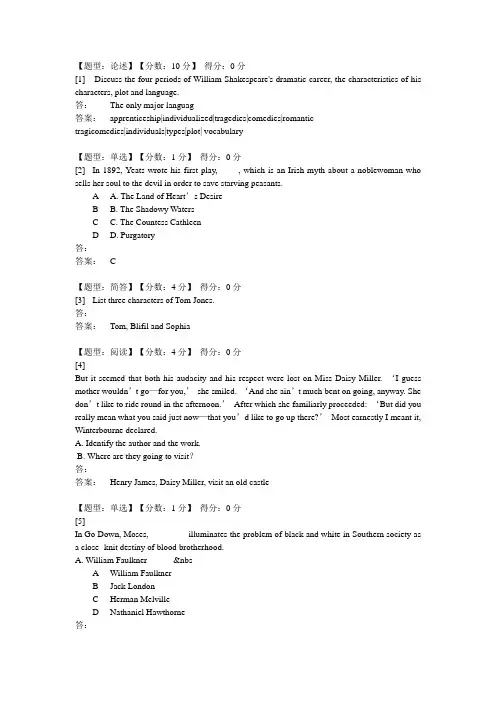
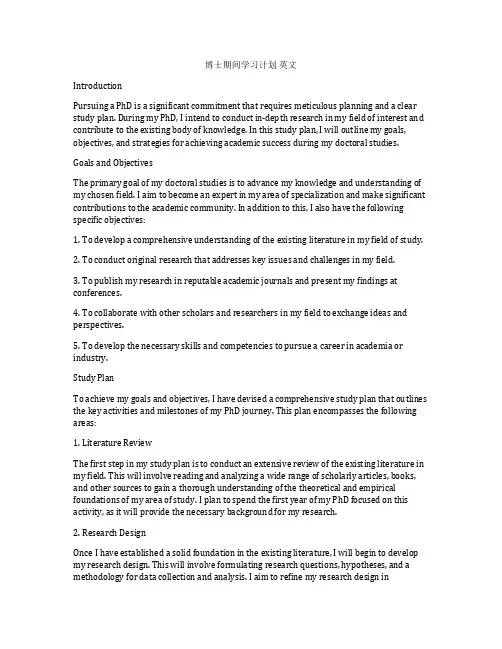
博士期间学习计划英文IntroductionPursuing a PhD is a significant commitment that requires meticulous planning and a clear study plan. During my PhD, I intend to conduct in-depth research in my field of interest and contribute to the existing body of knowledge. In this study plan, I will outline my goals, objectives, and strategies for achieving academic success during my doctoral studies.Goals and ObjectivesThe primary goal of my doctoral studies is to advance my knowledge and understanding of my chosen field. I aim to become an expert in my area of specialization and make significant contributions to the academic community. In addition to this, I also have the following specific objectives:1. To develop a comprehensive understanding of the existing literature in my field of study.2. To conduct original research that addresses key issues and challenges in my field.3. To publish my research in reputable academic journals and present my findings at conferences.4. To collaborate with other scholars and researchers in my field to exchange ideas and perspectives.5. To develop the necessary skills and competencies to pursue a career in academia or industry.Study PlanTo achieve my goals and objectives, I have devised a comprehensive study plan that outlines the key activities and milestones of my PhD journey. This plan encompasses the following areas:1. Literature ReviewThe first step in my study plan is to conduct an extensive review of the existing literature in my field. This will involve reading and analyzing a wide range of scholarly articles, books, and other sources to gain a thorough understanding of the theoretical and empirical foundations of my area of study. I plan to spend the first year of my PhD focused on this activity, as it will provide the necessary background for my research.2. Research DesignOnce I have established a solid foundation in the existing literature, I will begin to develop my research design. This will involve formulating research questions, hypotheses, and a methodology for data collection and analysis. I aim to refine my research design incollaboration with my supervisory committee and other experts in my field to ensure the rigor and validity of my study.3. Data Collection and AnalysisWith a clear research design in place, I will commence with data collection and analysis. This will involve gathering empirical evidence through interviews, surveys, experiments, or other methods, depending on the nature of my research. I will use appropriate statistical or qualitative techniques to analyze the data and draw meaningful conclusions from my findings.4. Writing and PublicationThroughout my doctoral studies, I plan to write and publish my research in reputable academic journals and present my findings at conferences and symposiums. I will also seek opportunities to collaborate with other researchers and scholars in my field to exchange ideas and perspectives and to receive feedback on my work.5. Collaboration and NetworkingIn addition to my individual research activities, I will actively seek opportunities to collaborate with other scholars and researchers in my field. This may involve joining research groups, attending seminars and workshops, or participating in academic exchanges. By fostering collaborations and networks, I hope to gain valuable insights and perspectives from others and contribute to the collective knowledge of my field.6. Skill DevelopmentFinally, I recognize the importance of developing the necessary skills and competencies to succeed in academia or industry. This may include attending workshops on research methods, writing, or teaching, as well as honing my presentation and communication skills.I will also seek opportunities to gain teaching experience, mentorship, and leadership roles to prepare for my future career.ConclusionIn conclusion, my study plan for my PhD is comprehensive and ambitious, encompassing a range of activities and milestones to achieve my goals and objectives. I am committed to conducting original and rigorous research, contributing to the existing body of knowledge, and developing the necessary skills and competencies to succeed in academia or industry. I am excited about the opportunities and challenges that lie ahead and look forward to making meaningful contributions to my field.。
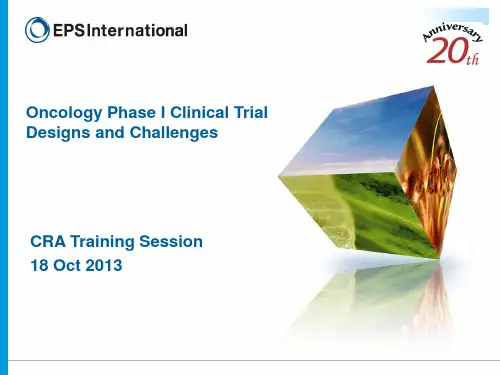
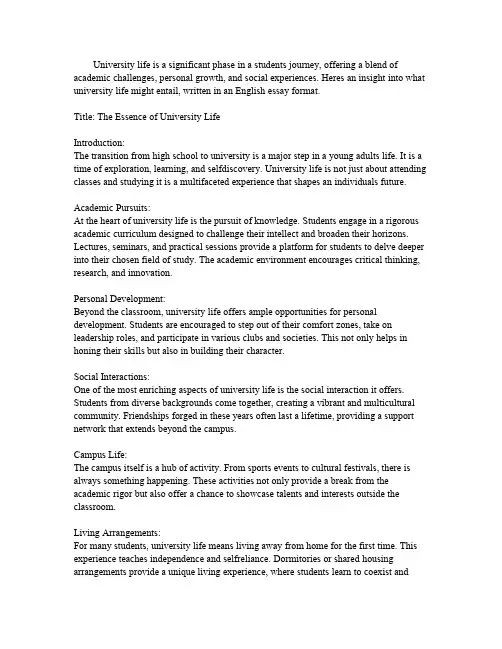
University life is a significant phase in a students journey,offering a blend of academic challenges,personal growth,and social experiences.Heres an insight into what university life might entail,written in an English essay format.Title:The Essence of University LifeIntroduction:The transition from high school to university is a major step in a young adults life.It is a time of exploration,learning,and selfdiscovery.University life is not just about attending classes and studying it is a multifaceted experience that shapes an individuals future. Academic Pursuits:At the heart of university life is the pursuit of knowledge.Students engage in a rigorous academic curriculum designed to challenge their intellect and broaden their horizons. Lectures,seminars,and practical sessions provide a platform for students to delve deeper into their chosen field of study.The academic environment encourages critical thinking, research,and innovation.Personal Development:Beyond the classroom,university life offers ample opportunities for personal development.Students are encouraged to step out of their comfort zones,take on leadership roles,and participate in various clubs and societies.This not only helps in honing their skills but also in building their character.Social Interactions:One of the most enriching aspects of university life is the social interaction it offers. Students from diverse backgrounds come together,creating a vibrant and multicultural community.Friendships forged in these years often last a lifetime,providing a support network that extends beyond the campus.Campus Life:The campus itself is a hub of activity.From sports events to cultural festivals,there is always something happening.These activities not only provide a break from the academic rigor but also offer a chance to showcase talents and interests outside the classroom.Living Arrangements:For many students,university life means living away from home for the first time.This experience teaches independence and selfreliance.Dormitories or shared housing arrangements provide a unique living experience,where students learn to coexist andrespect each others space and privacy.Career Preparation:Universities also serve as a bridge to the professional world.Internships,workshops,and career guidance sessions are integral parts of university life,preparing students for the job working events and industry interactions provide a glimpse into potential career paths.Conclusion:In essence,university life is a crucible where students are not only educated but also nurtured into becoming wellrounded individuals.It is a period of immense growth,both intellectually and personally,laying the foundation for a successful and fulfilling future.。
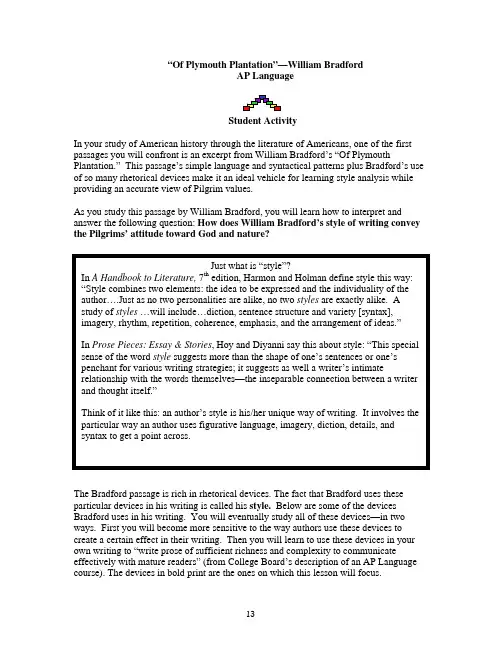
“Of Plymouth Plantation”—William BradfordAP LanguageStudent ActivityIn your study of American history through the literature of Americans, one of the first passages you will confront is an excerpt from William Bradford’s “Of Plymouth Plantation.” This passage’s simple language and syntactical patterns plus Bradford’s use of so many rhetorical devices make it an ideal vehicle for learning style analysis while providing an accurate view of Pilgrim values.As you study this passage by William Bradford, you will learn how to interpret and answer the following question: How does William Bradford’s style of writing convey the Pilgrims’ attitude toward God and nature?Just what is “style”?In A Handbook to Literature, 7th edition, Harmon and Holman define style this way: “Style combines two elements: the idea to be expressed and the individuality of the author….Just as no two personalities are alike, no two styles are exactly alike. A study of styles …will include…diction, sentence structure and variety [syntax], imagery, rhythm, repetition, coherence, emphasis, and the arrangement of ideas.”In Prose Pieces: Essay & Stories, Hoy and Diyanni say this about style: “This special sense of the word style suggests more than the shape of one’s sentences or one’s penchant for various writing strategies; it suggests as well a writer’s intimate relationship with the words themselves—the inseparable connection between a writer and thought itself.”Think of it like this: an author’s style is his/her unique way of writing. It involves the particular way an author uses figurative language, imagery, diction, details, and syntax to get a point across.The Bradford passage is rich in rhetorical devices. The fact that Bradford uses these particular devices in his writing is called his style. Below are some of the devices Bradford uses in his writing. You will eventually study all of these devices—in two ways. First you will become more sensitive to the way authors use these devices to create a certain effect in their writing. Then you will learn to use these devices in your own writing to “write prose of sufficient richness and complexity to communicate effectively with mature readers” (from College Board’s description of an AP Language course). The devices in bold print are the ones on which this lesson will focus.repetition metaphor litotes fragments inversion parallelism passive voice personification antithesis participles beginning sentences with coordinatingconjunctionsYou can first practice analyzing Bradford’s style by recasting some of his sentences into your own everyday language. You may find that you will have to write several sentences to his one. Try rewriting the first sentence of the passage:But to omit other things (that I may be brief) after long beating at sea they fell with that land which is called Cape Cod; the which being made and certainly known to be it, they were not a little joyful….Your rewrite:Now try rewriting the first sentence of the third paragraph of “The First Encounter”:And here it is to be noted a special providence of God, and a great mercy to this poor people, that here they got seed to plant them corn the next year, or else they might have starved, for they had none nor any likelihood to get any till the season had been past, as the sequel did manifest.Your rewrite:What specific and syntactical changes did you make? How is the effect different in both sentences?You will now practice using five devices that Bradford uses to create his particular style of writing.I.Beginning sentences with a coordinating conjunctionHere is one example from the first paragraph:“But to omit other things….”Find three more examples._______________________________________________________________________ e of participial phrasesHere is an example from the very first sentence:“…the which being made….”Find three more examples of participial phrases. You can find all three in one sentence from “The First Encounter.”Participial phrase____________________________________Participial phrase____________________________________Participial phrase____________________________________e of litotesLitotes is a type of understatement in which a thing isaffirmed by stating the negative of its opposite. To say“She was not unmindful” when one means that “Shegave careful attention” is to employ litotes. Although acommon device in ironic expression, litotes was alsoone of the characteristic figures of speech of OldEnglish poetry. When you express the idea thatsomething is “good” by saying it is “not bad,” you areusing litotes.Taken from A Handbook to Literature, WilliamHarmon and C. Hugh Holman, editors. 7th ed.Here is an example of litotes from the first paragraph:“…they were not a little joyful….”Find another example of litotes and write it.litotes_____________________________________________________________ e of passive voiceIn passive voice, the subject does not act; it is acted upon.Example: The student prepared the manuscript. (active voice)The manuscript was prepared by the student. (passive voice)The student isn’t doing anything in the second sentence; he/she is being acted upon.You can easily spot passive voice because it always uses some kind of is verb plus a past participle:The chord was struck by the choir.The mother was shocked by her child’s behavior.The sandwich is eaten by the boy.An indiscriminate use of passive voice can reveal weak sentence construction.However, there are legitimate uses for passive voice. It is useful when the doer of an action is unknown and thus cannot appear as the subject of the sentence or when the doer is not important enough to appear as the subject: Her new car was stolen right out of her garage. It is sometimes useful simply because the active voice wouldproduce an awkward sentence: During the wreck his right leg was broken in twoplaces.Passive voice is frequently used in the prose of bureaucrats to evade responsibility for their actions. It has been decided that your job must be terminated takes the boss right out of the picture.(Adapted from Prose Style: A Contemporary Guide, Robert Miles, Marc Bertonasco, William Karns, editors.)Look at this sentence from the second paragraph of “The First Encounter”:There was also found two of their [the Indians’] houses covered with mats, and sundry of their implements in them, but the people were run away and could not be seen. Underline the words in this sentence which indicate the use of passive voice. Edit this sentence, changing to active voice.active voice________________________________________________________________________________________________________________________________.Find two other sentences using passive voice.1.2.e of parallelismParallelism is one of the chief means by which you can achieve eloquence in your writing. Words or groups of words that are grammatically the same are joined—this is what parallelism is. Parallelism is characteristic of Hebrew poetry, being notably present in the Psalms, as in this example:The Heavens declare the glory of God;And the firmament sheweth his handiwork.Unfortunately, apprentice writers generally fail to take advantage of parallelism. It is an easy device to use in your own writing and easy to detect in the writing of others.Parallelism can be made up of only two equal elements—two words, phrases, orclauses. Here is a sentence from Madeleine Doran, Something About Swans:“Shakespeare’s noblest characters express sentiments of patriotic or personal[parallel adjectives]honor which to young modern ears sound flamboyant orunconvincing.” [parallel adverbs]Parallelism can also be used to join more than two elements and elements that areopposite rather than the same. In later lessons, you will learn other types ofparallelism such as antithesis, balanced sentences, triplet or triad, extendedparallelism, parallel sentences, and anaphora.(adapted from Handbook to Literature and Prose Style)Bradford uses so many parallel elements that almost every sentence contains parallelism, and because his sentences are frequently long, many sentences contain several examples. Third paragraph—“…they had now no friends to welcome them nor inns to entertainor refresh their weatherbeaten bodies; no houses or much less towns to repair, to seek for succor.” The infinitives and nouns create an orderly, thoughtful listing of the many trials the Pilgrims faced.Find at least four other examples of parallelism. Quote properly from the passage. parallelism____________________________________________________________ parallelism____________________________________________________________ parallelism____________________________________________________________ parallelism____________________________________________________________Find the figures of speech Bradford uses in these two sections.metaphor___________________________________________________ personification_______________________________________________Now you have identified seven devices of language that Bradford used in this passage—1.beginning sentences with coordinating conjunctions2.participial phrases3.litotes4.parallelism5.passive voice6.metaphor7.personificationRemember that the way an author uses language is called his/her style. It is not enough, however, to merely identify strategies an author uses. You must connect these strategies to the author’s purpose, to the tone and/or the theme. Remember the question you read at the beginning of this lesson?How does William Bradford’s style of writing convey the Pilgrims’ attitude toward God and nature?This question is worded much like one you will see on the AP Language exam.The question is really asking two tasks of you:1.What is William Bradford’s style of writing? (In other words,what rhetorical devices does he use to get across his point, andhow does he use them?)2.What is the Pilgrims’ attitude toward God and nature?The bigger and actually more difficult question here is #2. To know how to answer calls upon your close reading skills, your ability to infer, your critical thinking ability. You must get this part right, or it won’t matter much how well you can catalog all the rhetorical devices you find.So when you encounter an unfamiliar passage, before you begin finding the devices, you should settle in your mind just what the Pilgrims’ attitude seems to be toward God and nature. Obviously we have already found the devices in this lesson. To help you determine the Pilgrims’ attitude, fill in these blanks:The Pilgrims felt_____________________and_____________________toward God. (You may not be able to reduce your thought to one word. It’s fine to reword this sentence to say, “The Pilgrims felt that God….”The Pilgrims felt_____________________and_____________________toward nature. Now you’re ready to connect the Pilgrims’ attitude to the author’s style.a.Go back to the section on beginning sentences with coordinating conjunctions andread all the examples. Now write a sentence or two which explains why Bradford may have chosen to begin sentences this way.b.Go back to the section on participial phrases and read all the examples. Nowwrite a sentence or two which explains why Bradford may have chosen to useparticipial phrases. How do the participial phrases reveal his and the Pilgrims’attitude to God and nature?c.Go back to the litotes section and reread the examples. Now write a sentence ortwo which explains why Bradford may have chosen to use litotes. How does the use of litotes reveal his (and the Pilgrims’) attitude to God?d.Go back to the passive voice section and reread the examples. Now write asentence or two which explains why Bradford may have chosen to use passivevoice in some sentences. How does the use of passive voice reveal his attitudetoward God and nature?e.Go back to the parallelism section and reread the examples. Now write a sentenceor two which explains why Bradford may have chosen to use parallelism. Howdoes the use of parallelism reveal his attitude toward God and nature?f.Look at the metaphor and example of personification that you wrote. Now write asentence or two which explains why Bradford may have chosen to use theseparticular figures of speech. How do these figures of speech reveal his attitudetoward God and nature?Assume that this prompt is before you on the AP Language exam in May. (It won’t be.) Pretend you have never read “Of Plymouth Plantation” before. You have 40 minutes both to read the passage and to write an essay with these directions:How does William Bradford’s style of writing convey the Pilgrims’ attitude toward God and nature?Write only the introductory paragraph. You should not take more than five minutes, especially with all the preparatory work you have done. Make sure you address both tasks in the directions.。

求学志愿作文英语As I stand on the precipice of a new chapter in my life, I am filled with a sense of excitement and anticipation. The pursuit of higher education has always been more than just an academic goal for me; it is a calling that resonates with my deepest aspirations. In this essay, I aim to articulate my motivations, the influence of my personal experiences, and the specific academic and professional objectives that guide my quest for further study.Early InspirationsMy journey towards academic excellence began in my formative years, inspired by the stories of great minds like Albert Einstein and Marie Curie. Their dedication to knowledge and discovery sparked a curiosity in me that has only grown stronger with time. I have always been fascinated by the power of education to transform lives and societies, and I am eager to contribute to this noble cause.Personal ExperiencesGrowing up in a family that values education has been instrumental in shaping my aspirations. My parents, both educators themselves, have instilled in me the importance of lifelong learning. Their unwavering support and encouragement have been the bedrock of my academic journey, allowing me to explore various fields of study and to develop a well-roundedperspective.Academic InterestsMy academic interests have been diverse, ranging from the sciences to the humanities. However, it is in the field of environmental science that I have found my true passion. The pressing issues of climate change and sustainability have captured my attention, and I am determined to play a part in finding solutions to these global challenges. Higher education will provide me with the advanced knowledge and research skills necessary to make a meaningful impact.Professional GoalsProfessionally, I envision myself at the forefront of environmental policy-making, working to develop and implement strategies that protect our planet for future generations. I believe that higher education is the key to achieving this goal, as it will equip me with the expertise required to navigate the complex world of international environmental diplomacy.Choice of InstitutionThe institution I have chosen for my higher education is renowned for its commitment to research and innovation. Its faculty comprises leaders in their respective fields, and the institution's resources and facilities are unparalleled. I am confident that this environment will be conducive to my academic and personal growth.ConclusionIn conclusion, my aspiration to pursue higher education is driven by a deep-seated desire to learn, to contribute to the betterment of society, and to leave a positive mark on the world. I am fully committed to the challenges and opportunities that lie ahead, and I look forward to the day when I can look back on my academic journey with pride and satisfaction.。
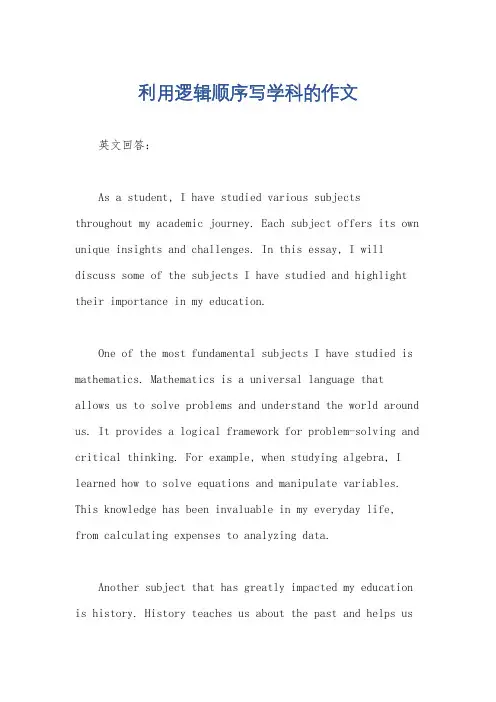
利用逻辑顺序写学科的作文英文回答:As a student, I have studied various subjects throughout my academic journey. Each subject offers its own unique insights and challenges. In this essay, I will discuss some of the subjects I have studied and highlight their importance in my education.One of the most fundamental subjects I have studied is mathematics. Mathematics is a universal language that allows us to solve problems and understand the world around us. It provides a logical framework for problem-solving and critical thinking. For example, when studying algebra, I learned how to solve equations and manipulate variables. This knowledge has been invaluable in my everyday life, from calculating expenses to analyzing data.Another subject that has greatly impacted my education is history. History teaches us about the past and helps usunderstand the present. By studying historical events and their consequences, we gain a deeper understanding of human nature and the complexities of society. For instance, learning about World War II not only taught me about the devastating consequences of war but also highlighted the importance of diplomacy and international cooperation.English literature has also played a significant role in my education. Through reading and analyzing literary works, I have developed critical thinking skills and a deeper appreciation for the power of storytelling. For example, reading Shakespeare's plays has exposed me to complex characters and intricate plots. It has also improved my language skills and expanded my vocabulary.Science subjects, such as biology and chemistry, have provided me with a scientific understanding of the world. These subjects have taught me about the intricacies of life and the physical world. For instance, studying genetics in biology has given me insights into heredity and the diversity of life forms. Chemistry, on the other hand, has helped me understand the composition and properties ofmatter.中文回答:作为一名学生,在我的学业过程中,我学习了各种各样的学科。
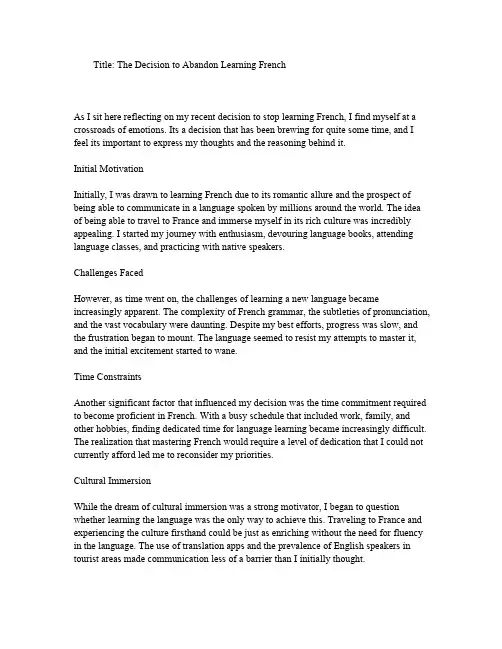
Title:The Decision to Abandon Learning FrenchAs I sit here reflecting on my recent decision to stop learning French,I find myself at a crossroads of emotions.Its a decision that has been brewing for quite some time,and I feel its important to express my thoughts and the reasoning behind it.Initial MotivationInitially,I was drawn to learning French due to its romantic allure and the prospect of being able to communicate in a language spoken by millions around the world.The idea of being able to travel to France and immerse myself in its rich culture was incredibly appealing.I started my journey with enthusiasm,devouring language books,attending language classes,and practicing with native speakers.Challenges FacedHowever,as time went on,the challenges of learning a new language became increasingly apparent.The complexity of French grammar,the subtleties of pronunciation, and the vast vocabulary were daunting.Despite my best efforts,progress was slow,and the frustration began to mount.The language seemed to resist my attempts to master it, and the initial excitement started to wane.Time ConstraintsAnother significant factor that influenced my decision was the time commitment required to become proficient in French.With a busy schedule that included work,family,and other hobbies,finding dedicated time for language learning became increasingly difficult. The realization that mastering French would require a level of dedication that I could not currently afford led me to reconsider my priorities.Cultural ImmersionWhile the dream of cultural immersion was a strong motivator,I began to question whether learning the language was the only way to achieve this.Traveling to France and experiencing the culture firsthand could be just as enriching without the need for fluency in the language.The use of translation apps and the prevalence of English speakers in tourist areas made communication less of a barrier than I initially thought.Reassessment of GoalsUltimately,the decision to abandon learning French was a result of a reassessment of my personal goals and interests.I realized that my passion for the language was not as strong as it once was,and the time and effort required to become proficient could be better spent on other pursuits that align more closely with my current interests and lifestyle. ConclusionIn conclusion,the decision to stop learning French was not made lightly.It was a choice born out of a desire to focus on what truly matters to me and to allocate my time and energy more effectively.While I may not be fluent in French,I still hold a deep appreciation for the language and the culture it represents.Perhaps one day,when the time is right,I may revisit the idea of learning French,but for now,my journey in language learning takes a different path.。
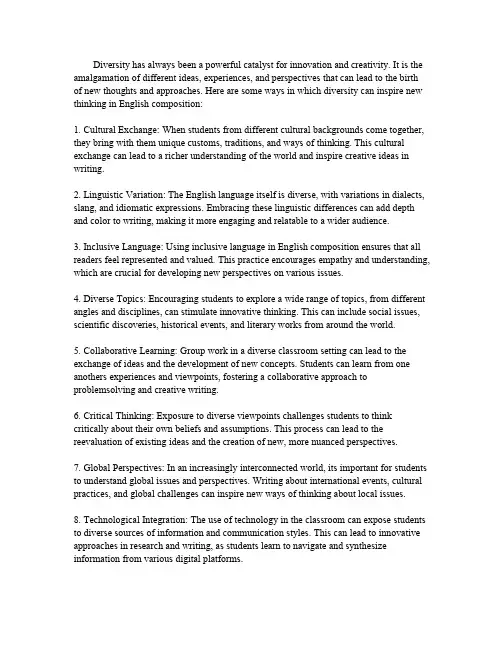
Diversity has always been a powerful catalyst for innovation and creativity.It is the amalgamation of different ideas,experiences,and perspectives that can lead to the birth of new thoughts and approaches.Here are some ways in which diversity can inspire new thinking in English composition:1.Cultural Exchange:When students from different cultural backgrounds come together, they bring with them unique customs,traditions,and ways of thinking.This cultural exchange can lead to a richer understanding of the world and inspire creative ideas in writing.2.Linguistic Variation:The English language itself is diverse,with variations in dialects, slang,and idiomatic expressions.Embracing these linguistic differences can add depth and color to writing,making it more engaging and relatable to a wider audience.3.Inclusive Language:Using inclusive language in English composition ensures that all readers feel represented and valued.This practice encourages empathy and understanding, which are crucial for developing new perspectives on various issues.4.Diverse Topics:Encouraging students to explore a wide range of topics,from different angles and disciplines,can stimulate innovative thinking.This can include social issues, scientific discoveries,historical events,and literary works from around the world.5.Collaborative Learning:Group work in a diverse classroom setting can lead to the exchange of ideas and the development of new concepts.Students can learn from one anothers experiences and viewpoints,fostering a collaborative approach to problemsolving and creative writing.6.Critical Thinking:Exposure to diverse viewpoints challenges students to think critically about their own beliefs and assumptions.This process can lead to the reevaluation of existing ideas and the creation of new,more nuanced perspectives.7.Global Perspectives:In an increasingly interconnected world,its important for students to understand global issues and perspectives.Writing about international events,cultural practices,and global challenges can inspire new ways of thinking about local issues.8.Technological Integration:The use of technology in the classroom can expose students to diverse sources of information and communication styles.This can lead to innovative approaches in research and writing,as students learn to navigate and synthesize information from various digital platforms.9.Reflective Practices:Encouraging students to reflect on their own experiences and identities in relation to the diverse world around them can lead to personal growth and new insights.This introspection can be a powerful tool for developing original ideas in writing.10.Interdisciplinary Approaches:Combining knowledge from different academic disciplines can lead to innovative thinking.For example,a student might draw on both history and literature to explore the impact of a particular event,or use insights from psychology to analyze a characters motivations.By embracing diversity in all its forms,students can unlock a wealth of new ideas and perspectives that can enrich their English compositions and enhance their overall learning experience.。
宁波2024年小学英语能力测评考试时间:80分钟(总分:100)B卷考试人:_________题号一二三总分得分一、选择题(共计20题,共40分)1、What is the term for a young female deer?A. FawnB. CalfC. KidD. Lamb答案:A2、What is the main ingredient in bread?A. FlourB. SugarC. MilkD. Water3、What is the term for a young female cow?A. HeiferB. BullC. CalfD. Doe4、What do we call the study of animal behavior?A. PsychologyB. SociologyC. EthologyD. Ecology答案:C5、What do you call a large, flightless bird native to Australia?A. EmuB. KiwiC. PenguinD. Ostrich答案:A6、选择题:What is 30 ÷ 3?A. 5B. 7C. 9D. 107、What is the capital of Estonia?A. TallinnB. TartuC. NarvaD. Pärnu答案:A8、What is the capital of Finland?A. HelsinkiB. OsloC. StockholmD. Reykjavik9、What do we call the process of converting food into energy in living organisms?A. DigestionB. MetabolismC. AbsorptionD. Respiration10、What is the main ingredient in a smoothie?a. Juiceb. Milkc. Fruitd. Sugar答案:C11、Which of these is a mode of transportation?A. TableB. CarC. ChairD. Bed12、What is the capital city of France?A. BerlinB. LondonC. ParisD. Madrid13、What is the tallest mountain in the world?A. K2B. KilimanjaroC. EverestD. McKinley14、What do you call a young moose?A. CalfB. PupC. KitD. Fawn答案:A15、选择题:What do we call a person who studies plants?A. BotanistB. ZoologistC. GeologistD. Ecologist16、选择题:Which season comes after spring?A. WinterB. SummerC. AutumnD. Rainy17、What is the main ingredient in pasta?A. RiceB. WheatC. CornD. Barley18、What is the name of the region in the center of a black hole?A. SingularityB. Event HorizonC. Accretion DiskD. Photon Sphere19、What do we call a vehicle that flies?A. CarB. BoatC. AirplaneD. Train20、Which country is known as the Land of the Rising Sun?a. Chinab. Japanc. Thailandd. India答案:b二、听力题(共计20题,共40分)1、听力题:The __________ is a long area of land that is surrounded by water on three sides.2、听力题:The __________ can help scientists understand earth's history.3、听力题:I like to _____ (修理) things.4、听力题:The __________ of a fish can help it steer while swimming.5、听力题:The ____ has a thick coat to protect it from the cold.6、听力题:The study of how landscapes evolve is part of ______ science.7、听力题:The __________ is very tall.8、听力题:The stars are ______ (twinkling) in the dark night.9、听力题:Canada is north of the _______ States.10、听力题:A chemical formula shows the types and numbers of ________ in a compound.11、听力题:The __________ is a region where the ocean meets the land.12、听力题:My sister is a ______. She loves to volunteer at shelters.The process of ______ involves the movement of rocks due to gravity.14、听力题:A baby dog is called a ______.15、听力题:We go to the __ on weekends. (beach)16、听力题:My friend is a ______. He enjoys discussing current events.17、听力题:A _______ is a reaction that involves the breaking of chemical bonds.18、听力题:My cousin is a great ____ (chef).19、听力题:He enjoys playing with his ___. (toys)20、听力题:The ______ is a large mammal that lives in the ocean.三、填空题(共计20题,共10分)1、填空题:A _____ is a large area of water that is deep.2、填空题:The ______ (种子) can be planted to grow new plants.3、填空题:The country known for its ancient ruins is ________ (希腊).4、填空题:Botanical gardens often have ______ (教育) programs.5、填空题:I like to plant ______ (花) in the garden.6、填空题:The __________ (生态破坏) must be addressed.A parrot can ______ many words.8、填空题:I love to ______ (阅读) books.9、填空题:We are learning _______ (英语) in school.10、填空题:The ________ (生态系统服务评估) informs policies.11、填空题:The ________ was a war fought for independence from British rule.12、填空题:My friends and I have a toy ____ competition. (玩具名称)13、填空题:The skunk's spray is a powerful ________________ (防御).14、填空题:The __________ (历史的变化) can be gradual or sudden.15、填空题:A ________ (植物观察志愿者) contributes to knowledge.16、填空题:My favorite season is ______ (春天). Everything comes back to ______ (生命).17、填空题:Wildflowers add beauty to __________ (自然环境).18、填空题:_____ (温暖) weather helps many plants thrive.19、填空题:I take my ________ (玩具名称) wherever I go.20、填空题:Plants can also _____ (提供) food for animals.。
探索英语世界:初一下册的半期考试之旅 In the midterm of the first semester of junior high school, the English exam served as a pivotal milestone in my academic journey. It was not just a test of mylinguistic skills but also a reflection of my dedication and perseverance. The experience taught me valuable lessons about the beauty and challenges of the English language.The exam,全面的考试,covered a diverse range of topics from vocabulary and grammar to reading comprehension and writing skills. The questions were designed to test our understanding of the English language and our ability to apply it in practical situations. The reading comprehension section, in particular, challenged me to think critically and analyze complex texts.Preparing for the exam was a challenging yet rewarding experience. I had to revise the entire semester's curriculum, focusing on the key concepts and vocabulary. I practiced writing essays and doing exercises to improve my grammar and vocabulary. The process was arduous, but it paid off in the end when I was able to confidently answer the questions on the exam.The writing section of the exam was particularly noteworthy. It required us to write an essay on a given topic, demonstrating our ability to organize ideas, use appropriate vocabulary, and construct coherent sentences. I found this task to be both exciting and challenging. It was exciting to have the freedom to express myself creatively while also being challenging to ensure that my writing was grammatically correct and coherent.After the exam, I realized the importance of regular practice and revision. The exam was not just a test of my knowledge but also a test of my commitment and dedication. It taught me that success in English requires consistent effort and practice. It also taught me to appreciate the beauty of the language and the power of communication it holds.In conclusion, the midterm exam was a valuable learning experience that helped me grow as a language learner. It taught me the importance of dedication, perseverance, and regular practice. It also highlighted the beauty and challenges of the English language, inspiring me to explore it further. As I continue my journey in English, I amexcited to embark on new adventures and learn more aboutthis fascinating language.**探索英语世界:初一下册的半期考试之旅**初一的下半学期,英语考试成为了我学术旅程中的一个重要里程碑。
英语作文optional studyEnglish:Optional study is becoming an increasingly popular trend among students, as it allows them to pursue their personal interests and passions while also enriching their knowledge. The benefits of optional study are manifold, ranging from providing a stimulating learning environment to improving one's CV and employability prospects. Moreover, optional study enables students to explore new and fascinating subjects that they may not have had the chance to study otherwise.However, there are also certain challenges associated with optional study, such as the need to balance it with one's core academic responsibilities and workload. In addition, optional study can be costly, both in terms of finances and time, and may require a significant commitment on the part of the student. Therefore, it is important for students to carefully consider their options and weigh the costs and benefits of optional study before committing to it.Nevertheless, with the right approach and mindset, optional study can be a highly rewarding and enriching experience. It allows students to develop their intellectual curiosity and engage in lifelong learning, while also enhancing their personal and professional development. As such, I believe that optional study should be encouraged and supported at all levels of education, as it can help students unleash their full potential and lead fulfilling lives.Translated content:选修学习正成为越来越流行的学习方式,因为它使学生在追求自己的个人兴趣和激情的同时,也丰富了他们的知识。
My English Garden: A Blossoming JourneyAs a high school student, Ive always been fascinated by the beauty of the English language, and my journey with it has been nothing short of a blossoming garden. Its a place where Ive planted seeds of curiosity, nurtured them with dedication, and reaped the fruits of understanding and expression.My initial encounter with English was akin to stumbling upon a wild, untamed plot of land. It was during my first year of middle school when I was introduced to this new language. The alphabet seemed like a maze of unfamiliar symbols, and the pronunciation was a symphony of sounds that my tongue struggled to mimic. Yet, there was something enchanting about it, a melody that beckoned me to explore further.The first seeds of learning were planted in the classroom, where our teacher, Mrs. Wang, would patiently sow the basics of grammar and vocabulary. Her lessons were like the watering can, providing the necessary nourishment for my linguistic garden. I remember the first time I managed to string together a simple sentence, I like apples. It was a small victory, but it felt like the first sprout breaking through the soil.As the days turned into weeks, my garden began to flourish. I started to read English books, starting with childrens literature and gradually moving on to more complex texts. Each book was like a new flower in my garden, adding color and variety to my linguistic landscape. I was particularly captivated by the works of J.K. Rowling, whose magical world of HarryPotter opened up a realm of imagination and wonder.Listening to English songs also became a part of my daily routine. Artists like Taylor Swift and Ed Sheeran not only provided me with a soundtrack to my life but also helped me understand the rhythm and intonation of the language. Their lyrics were like the sun, illuminating the subtleties of English expressions and idioms.The real challenge, however, was speaking. It was one thing to read and listen, but quite another to articulate my thoughts in a language that wasnt my mother tongue. I felt like a gardener trying to cultivate a rare and delicate flower, knowing that it required just the right amount of care and attention. I practiced speaking with my classmates, participated in English debates, and even dared to converse with foreign visitors who came to our school.One memorable incident was when I had the opportunity to give a speech in English at a school event. The preparation was intense, with countless hours spent refining my speech and practicing my pronunciation. When the day came, I stood on the stage, my heart pounding like a drum, but as I began to speak, a sense of calm washed over me. The words flowed like a river, and I could see the audience nodding in understanding. It was a moment of triumph, like watching a flower bloom in full glory.My English garden is not just about the language itself its also about the friendships Ive made along the way. Ive connected with people from different cultures, exchanged ideas, and learned about their customs andtraditions. These interactions have been like the crosspollination between flowers, enriching my garden with diverse perspectives and experiences.Looking back, my journey with English has been a continuous process of growth and discovery. There have been times when Ive felt like giving up, when the grammar seemed too complex or the pronunciation too challenging. But just like a gardener who doesnt give up on a struggling plant, Ive persisted, knowing that with patience and care, my garden will continue to thrive.Today, my English garden is a vibrant and thriving ecosystem, filled with the fragrance of knowledge, the colors of different cultures, and the sounds of a language that has become an integral part of my identity. Its a place where I can express my thoughts, share my stories, and connect with the world in a way that I never thought possible. And as I continue to tend to this garden, I know that it will keep on blossoming, bringing forth new flowers of understanding and new fruits of wisdom.。
人工智能英语作文考博The Evolution and Future Prospects of Artificial Intelligence.Artificial intelligence (AI) has emerged as a transformative technology, revolutionizing various fields from healthcare to finance, transportation to education.Its ability to process vast amounts of data, learn from experiences, and make predictions has made it a valuable asset in today's world. As we delve into the realm of doctoral-level research in AI, it becomes crucial to understand its historical background, current advancements, and potential future implications.Historical Perspective.The concept of AI dates back to the early 20th century, with Alan Turing's ideas on machine intelligence. However, it was in the 1950s when the term "Artificial Intelligence" was coined, and researchers began exploring thepossibilities of creating machines that could think and learn like humans. Since then, AI has gone through various phases of development, from expert systems in the 1970s to machine learning and deep learning in recent years.Current Advancements.In recent years, AI has made leaps and bounds in terms of technology and application. Machine learning algorithms, such as neural networks and support vector machines, have enabled computers to learn from data without beingexplicitly programmed. Deep learning, a subset of machine learning, has further enhanced AI's capabilities by allowing it to process and interpret large amounts of unstructured data.AI is now being used in various industries to improve efficiency, accuracy, and decision-making. In healthcare, AI-powered diagnostic tools can assist doctors in identifying diseases at earlier stages. In finance, AI algorithms can analyze market trends and predict future outcomes, aiding investors in making informed decisions. Intransportation, self-driving cars and trucks are being developed to reduce accidents and traffic congestion.Future Prospects.The future of AI looks bright, with numerous potential applications and implications. With the increasing availability of data and computing power, AI will become even more sophisticated and capable. We can expect to see more AI-powered robots assisting humans in various tasks, from domestic chores to hazardous industrial work. AI will also play a crucial role in addressing global challenges like climate change and resource management.However, the rise of AI also brings concerns about job displacement, ethical implications, and privacy issues. As AI systems become more autonomous and capable, there will be a need for robust frameworks and policies to ensure their ethical use. There will also be a need for more research and development in areas like explainable AI and AI ethics to ensure that AI systems are transparent and accountable.Conclusion.Artificial intelligence is poised to revolutionize our world in ways we can only imagine. As we delve intodoctoral-level research in this field, it is crucial to understand AI's historical background, current advancements, and potential future implications. By doing so, we can harness its power to create a better, more sustainablefuture for all.。
As a high school student, the prospect of pursuing a Ph.D. seems both distant and daunting. The idea of dedicating several years of my life to a single area of study is something that Ive often pondered, weighing the potential benefits against the sacrifices that such a commitment would entail.My journey towards considering a Ph.D. began in my junior year when I took part in a science fair. The project I worked on was a smallscale study of the effects of certain nutrients on plant growth. It was a simple experiment, but it sparked a deep curiosity within me about the natural world and the scientific method. I found myself engrossed in the process of hypothesis formulation, data collection, and analysis. The thrill of discovery, even on such a small scale, was exhilarating.As I progressed through high school, my interest in science continued to grow. I took advanced courses in biology, chemistry, and physics, each one deepening my understanding and appreciation for the complexity and beauty of the natural world. My teachers, recognizing my passion, encouraged me to think about a future in research. They spoke of the joys of contributing to the body of human knowledge, of the satisfaction that comes from solving puzzles that have long eluded understanding.However, the decision to pursue a Ph.D. is not one to be taken lightly. It requires a level of commitment that is akin to a marriage, where one must be prepared to dedicate a significant portion of their life to their chosen field. Ive heard stories of the long hours spent in laboratories, the countless pages of research papers to be written, and the intense pressureto produce results that are both novel and significant.Moreover, the financial implications of such a decision cannot be ignored. While there are often scholarships and stipends available for Ph.D. students, the prospect of living on a modest income for several years is a reality that must be faced. This is not to mention the opportunity cost of not entering the workforce during this time, which could lead to a different set of financial benefits.Despite these challenges, the allure of a Ph.D. remains strong. The chance to delve deeply into a subject that I am passionate about, to contribute to the advancement of knowledge in my field, and to potentially make a difference in the world is incredibly appealing. Ive read about researchers who have made groundbreaking discoveries, whose work has led to new treatments for diseases, or who have unlocked secrets of the universe, and I cant help but feel a sense of awe and admiration for their dedication and perseverance.In addition, the skills acquired during a Ph.D. program are invaluable. Critical thinking, problemsolving, and the ability to communicate complex ideas effectively are all skills that are transferable to many different careers. Even if I were to leave academia after my Ph.D., these skills would serve me well in a variety of professional settings.As I stand on the precipice of my future, the decision to pursue a Ph.D. is one that I continue to wrestle with. I am torn between the desire to explore the depths of my chosen field and the practical considerations of time,money, and the potential for a different kind of career path. What I do know is that the journey towards a Ph.D. is not one that should be embarked upon lightly. It requires a deep passion for ones subject, a willingness to face challenges headon, and the resilience to persevere through the inevitable setbacks.In the end, whether or not I choose to pursue a Ph.D., the experience of considering this path has been invaluable. It has forced me to reflect on my interests, my goals, and what I value most in life. And no matter what path I choose, the lessons learned from this contemplation will undoubtedly serve me well in the years to come.。